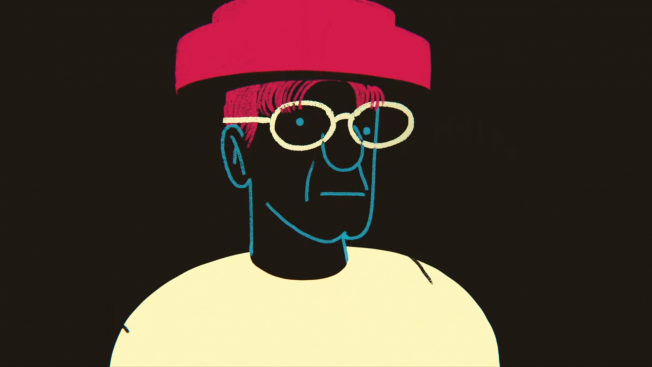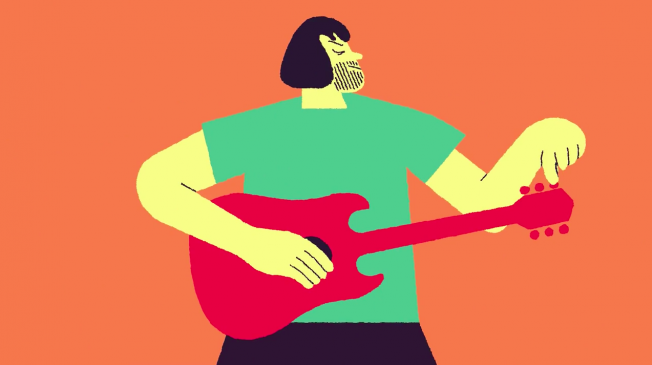
Google Play has been running a great branded content series from BBH Los Angeles called “California Inspires Me,” featuring interviews—which are then set to animation—with famous Californians talking about their upbringing. It’s a collaboration with California Sunday magazine (the regional print offshoot of nonfiction event series Pop-Up Magazine), and the results have been fantastic.
The latest spot in the series breaks today, featuring Devo’s Mark Mothersbaugh, who explains how he grew up legally blind and initially wasn’t that interested in music. It’s a lovely way to tell these kinds of stories. Have a look here:
To get an idea of how this campaign works behind the scenes, AdFreak chatted with Josh Webman, creative director at BBH L.A.
AdFreak: Can you describe the collaboration between BBH, California Sunday and Google Play? Who’s responsible for what?
Josh Webman: Everyone at Google and BBH loved the Pop-Up Magazine series. It was an incredible, sort of, “happening,” where on one night different artists, journalists and filmmakers present their work on stage—and then it all goes away. Nothing is filmed or recorded. As it turned out, Pop-Up was starting a new magazine series called California Sunday, and they were really interested in story advertising. The timing was perfect.
We all worked together to create the “California Inspires Me” series of print ads and animated films. It’s been a true collaboration between the three partners, with everyone bringing value to the work. We’re fortunate to have a client like Google Play, who is a big believer in creating advertising that doesn’t feel like advertising and putting content out into the world that is authentic and inspiring.
How do you choose the interviewees?
We all kind of go around the room and try to think about who has a truly unique story. Whose story would be fun to bring to life? Everyone has a say.
What’s the process like for the interviews? Do you sit down and have a long chat and then pick the best part? Is it more structured than that?
The studios team at California Sunday is amazing at getting people to open up. They have a deep roster of producers and writers from This American Life and public radio, who have a knack for getting the most interesting morsels out of their subjects. We would then all pore over the interview and transcripts afterwards, pick out the nicest bits, and start carving out a narrative.
Is the audio edited a lot?
We usually have somewhere between 45 minutes to an hour and a half of unedited conversation. Then, we cut down—as is always the case, we end up having to kill a few of our babies for the sake of a nice, tight story.
Do you then find animators to put pictures to the words?
Actually, we are already researching animators well in advance of the interview. Sometimes, this is the hardest part of the whole process, because each one of us has this back-pocket, laundry list of animators we’ve been dying to work with. So we’re all kind of jockeying for our favorites. But it all becomes a little clearer when we finally land on an interview subject. There was always a “eureka” moment, where we knew the subject and the animator just belonged together. It’s matchmaking.
What led you to Mark Mothersbaugh?
Who doesn’t love Devo? We were all fans. But really, Mark is so much more than Devo. He has such a dynamic and varied body of work, and the trajectory of his career has taken so many fascinating and unexpected turns. It felt like, “Why wouldn’t we want to tell that story? It’s riveting.”
In many ways, he embodies what we think of when we think of a multidimensional artist. He just has so many tools in his belt. And his personal story—how he “made it,” how he became who he is—is just as interesting as the art he creates. Mark has influenced whole generations, and in different mediums, too. He just seemed perfect for this project.
You got Madrid-based directing duo Manson to direct this. Why them?
Because they’re amazing. That’s the short answer. The long answer is, our design director, Florencio Zavala, came across the work of street artist/illustrator SAWE—one half of Manson—and we were all blown away. After one viewing of Tomás’s work as well, we knew we had to work with this crew. Mark’s story is fascinating, and we knew these guys would really elevate it. And they did. Knocked it out of the park.
What other videos have you done?
We’ve done “California Inspires Me” profiles on director Mike Mills, and the indie singer Thao Nguyen. And of course, Jack Black. We are hard at work on the next few installments, and they are great, really interesting, inspiring people whose stories are told beautifully. The diversity of the subjects is key, so we are trying to surprise people. We really hope everyone likes them.
The whole series has a dreamy vibe. Was that the intent all along?
We think so. It’s the California way, right? We’re all based in California—BBH L.A., Google Play, and California Sunday—so we wanted to have that feeling come across in the films, but subtly—we didn’t want to be heavy handed about it.
We wanted to get across the surprising way the state of California can be this great, unexpected haven for creativity—a place for dreamers and misfits. There’s a certain allure there, and an ideal that feeds right into a dreamy fantasy. To that end, we do always ask the illustrators to give us a bit of a surreal/fantasy vibe. That’s the great thing about animation: You can open it up and tell a person’s story in a less formal way.
What is the series trying to say, deep down, about California?
California is thought of as a lot of different things. Thanks in part to the film industry, we know it’s a place where artists come to, but it’s also a place where artists come from. It is a creative mecca as rich and diverse as any in the world, from the beat scene in the ’50s, Haight-Ashbury, Beautiful Losers, Ray and Charles Eames to Compton, Silicon Valley, Sound City, the Sunset Strip, Disney, Pixar, CalArts and Grand Royal.
California is a place where people not only find their footing, but grow and bloom, developing as people and as artists. BBH, California Sunday and Google Play wanted to shine a light on that idea. It really is a magical place, and it’s cool to hear how California does in fact inspire people. We’re all hoping, in our own way, that the series inspires others as well.
See the previous videos from the series here:









